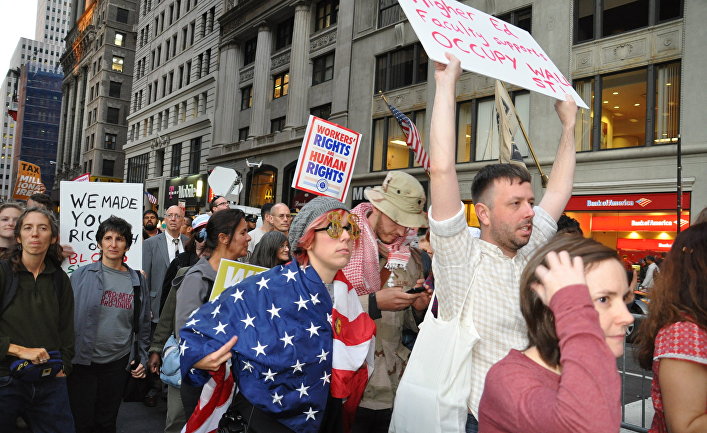
Throughout the history of social movements a small, almost unrelated groups, United by one goal, provoked a qualitative change. Sufrazhyzm and the struggle for civil rights in the United States, for the independence of India, the color revolutions in Eastern Europe and the Arab spring — all of this is based on the Union of the weak against the strong.
An important role is played here by the protests. Take a look at the recent March in Poland against an unpopular law which restricted the right to abortion. They have inspired millions to take further action — including strikes — in the result, he forced legislators to back off.
However, even such large-scale marches like the recent vs trump is only the first step. There are several reasons why some movements succeed and others don’t, and activists need to learn from mistakes. To really influence the situation, the movement needs to make five steps.
Step one: determine what you want to change
A clear definition of the changes that need to happen — the keynote of successful movements. The participants of the civil rights movement wanted specific changes in the laws. Gandhi wanted independence from the British. During the color revolutions demanded regime change. It was a tangible goal around which it was possible to build a strategy.
During the Serbian Bulldozer revolution, which helped to hold Srdja Popovich, the goal was to rid the country of dictator Slobodan Milosevic. Point. Full stop. Without ambiguity. It seemed impossible, because Milosevic ruled the country with an iron hand. However, the goal was achieved.
What is the aim of the women’s marches? They were carried out in order to remove Donald trump as President? Were the marchers against a particular political line or for her? Those who came with such enthusiasm, had to ask the question “If you could wave a magic wand to change something, what would it be?”. If even such a simple question is not answered, then what’s the point of these marches?
The need to articulate the purpose becomes obvious when you look at a failed movement. For example, as noted by Joe Naser, the movement “Occupy wall Street” “it was a lot of complaints mainly against the “oppression of corporations,” but they “did not go beyond slogans.” It is not enough just to show that it works incorrectly — it is necessary to be clear what you want instead.
The revolution starts not with the slogan and vision of the changes that you want to achieve. This does not mean that you have to be adamant. You should not try to impose your vision — do you share them, listen, you respect those who do not share your views. But first of all — you know, what defended.
Step 2: Expanding the circle of allies
Once you have clearly identified what changes you want, for their implementation it is necessary to examine the allies. Determine from whom you can expect active or passive support, who will at best be neutral, and at worst — will be in active or passive opposition. Wrote sun Tzu, “Know yourself, your enemy and terrain”. Spectrum of allies — a territory.
Successful movements seek not just to defeat their opponents; they gradually deprived of the support of opponents. Start with those who are open to change, and overcome increasingly difficult levels of resistance. In other words — you need to start with the mobilization of active allies and major supporters. Once you start to defeat the opposition among the passive, you will be on the verge of victory.
For example, the civil rights movement Martin Luther king Jr. and his contemporaries began with the mobilization of blacks in the South, and then moved on to the introduction of white from the North. And when Harvey milk started the movement for LGBT rights, he started with gays on Castro street, and then took over the liberals in the Bay area of San Francisco.
To win you need not to create a coalition rejected, and Express their values so clearly to convince others to join the cause. Empire die not because people struggle with them, and because they support the destruction. To win you must convince others that the problem exists.
Step 3: Define the pillars of power
No less important than the selection of allies is the identification of institutions that can implement the desired changes. It is impossible to make changes alone, and all who possess some kind of authority depends on those who execute the orders.
These “pillars” can be the police, the media, education system, public institutions or other organizations. Despite the importance of popular support, change is unlikely to happen without the support of the institutions. For example, to affect the criminal justice system will have to enlist the support of the police, judges and prosecutors.
In Serbia, a revolutionary group Otpor believed the arrests not only an act of disobedience, but an opportunity to build good relations with the police. In particular, the protesters have been trained to protect officers from provocations in their own ranks. In the end, when the police had to decide whether to shoot at the crowd or to join it, they chose the latter.
Who inside or outside the corridors of power can implement or resist change? What are their reasons? What they will get or what will be affected by the changes you require? That’s all you need to understand.
Step 4: Seek to attract, rather than to overcome
Each movement seeks to correct some injustice, but it can get into the trap of demonizing the other side. At this stage, many movements have fallen by the wayside. Anger is an effective tool of mobilization, but without hope is devastating. You need to create a positive business with positive tactics.
So you should start with small attainable goals. Allies Gandhi doubted his idea to make the salt tax the Central issue of the Indian independence movement because he advocated a comprehensive change, but he realized that one issue, even small, can unite the nation and break the monopoly of the British Raja on the government.
Cheap tactics with a scalable and low-risk most successful. It helps to mobilize the needed number of allies in order to influence the seat of government. No matter whether we are talking about destruction, mobilize or attract people into allies, especially if the tactic is perceived as positive and good-natured.
Blocking streets and throwing stones at the police rather eliminate them from possible allies, and significantly complicate gaining the support of representatives of the pillars of power. During the presidential campaign in the US Bro Bernie may have made the most ardent supporters of Bernie Sanders, but they probably alienated many who were needed to win.
Step 5: Develop a conservation plan for victory
Oddly enough, one of the most dangerous stages of the revolution occurs immediately after the victory. During the Ukrainian Orange revolution of 2004 winning team are unable to create a unified and effective government, and the country soon again engulfed the chaos. In Egypt 2011 the main driving force was a secular protesters, but in the end the election was won by the “Muslim brotherhood”.
It is important not to confuse movement for change with the values they represent. The fact that you won the election and approved its programme and received money for it, does not mean victory. In fact, at this moment you need to maintain allies and to convince stakeholders that change in the first place.
Writes Moises Naim in the “End of power”, today “it is easier to gain power than to use it and keep it.” “To really change something, not just to change policies or change the regime. You need to change the beliefs that lead to action.”
To join the campaign or to throw a stone don’t need much. History is made by those who can pave the way forward and to convince others — even the skeptics — that the journey should start.
Greg Satell, Forbes correspondent, former co-Director of the publishing holding KP Media.







